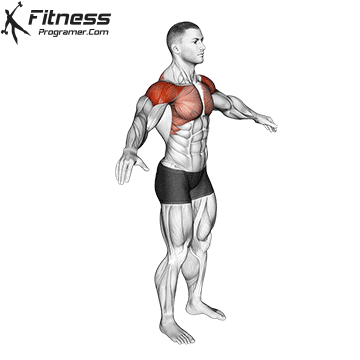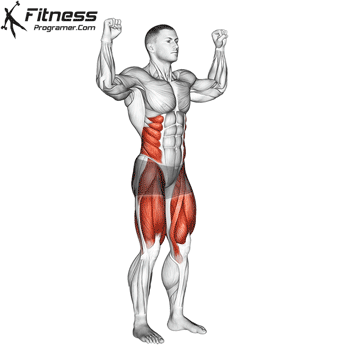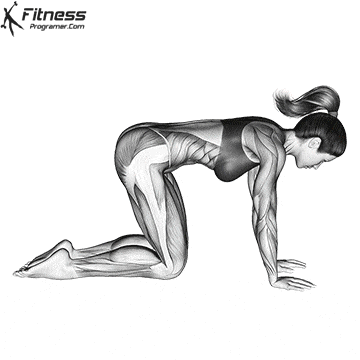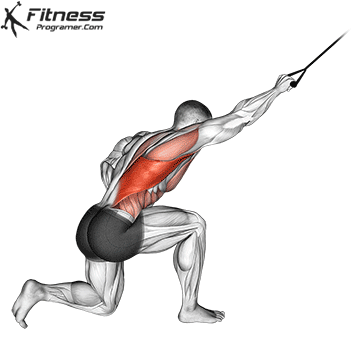Contents
The key to a proper warm-up is to get your body ready to lift heavy weights without wearing yourself down. Warm-up exercises consist of a series of low-intensity exercises that prepare the body for more vigorous physical activity.
A proper warm-up can increase blood flow, improve flexibility, and reduce the risk of injury. This is because when you warm up, your body temperature rises, which helps to increase blood flow to the muscles. It also provides mental preparation, allowing you to focus on your workout and get the most out of your exercise session.
In this blog post, we will explore the benefits of designing a specific warm-up routine for your workout goals and provide tips on how to create a warm-up routine that is tailored to your needs. By the end of this post, you will have the knowledge to create an effective and safe warm-up routine that will enhance your exercise experience.
Why it’s important to design a warm-up routine:
- Helps to prevent injury: By focusing on the muscles and movements used in your workout, you can reduce the risk of injury during exercise.
- Improves performance: A specific warm-up routine can enhance your exercise experience by improving your flexibility, strength, and range of motion, resulting in better overall performance.
- Saves time: An effective warm-up routine can help you get the most out of your workout in a shorter amount of time by preparing your body efficiently.
Warm-up vs Stretching
Warm-up and stretching are both important components of any exercise routine, but they serve different purposes.
warm-up
A warm-up is a brief period of low- to moderate-intensity activity that is designed to prepare the body for exercise. The purpose of a warm-up is to gradually increase heart rate, blood flow, and body temperature, which can help prevent injury and improve performance. A good warm-up typically involves performing movements that are similar to those in the upcoming exercise or activity, such as jogging or light calisthenics.
Stretching
Stretching, on the other hand, involves elongating and lengthening the muscles to increase flexibility and range of motion. The purpose of stretching is to improve joint mobility, reduce muscle soreness, and prevent injury. There are two main types of stretching: static stretching and dynamic stretching.
1-) Static stretching involves holding a stretch position for a period of time, usually 10-30 seconds, while the muscle is relaxed. This type of stretching is often done after a workout or at the end of a warm-up routine.



2-) Dynamic stretching, on the other hand, involves moving the body through a range of motion to warm up the muscles and prepare them for exercise. This type of stretching is typically done as part of a warm-up routine before exercise.



In summary, a warm-up is designed to prepare the body for exercise, while stretching is designed to improve flexibility and prevent injury.
Warm up vs Cooldown
While warm-up and cooldown are both important components of a workout, they serve different purposes and involve different types of exercises.
The main difference between warm-up and cooldown is that warm-up is done before starting any physical activity or workout routine to prepare the body for the exercise while cooldown is done after the exercise to bring the body back to a resting state.
Typically, a cooldown routine involves light exercises, such as walking or slow jogging, followed by static stretching or foam rolling to help release any tension built up during the exercise. The purpose of cooling down is to promote recovery, reduce muscle soreness and stiffness, and gradually bring the body back to a resting state.
What is Sport Specific Warm-up
Sport-specific warm-up is a type of warm-up that is designed to prepare the body for a specific sport or activity. The goal of a sport-specific warm-up is to prime the muscles, joints, and other physiological systems used in the sport or activity, so that the athlete is ready to perform at their best.
A sport-specific warm-up will typically include exercises that mimic the movements, intensity, and duration of the sport or activity. For example, a basketball warm-up might include exercises such as dribbling, layups, and shooting drills. A soccer warm-up might include exercises such as jogging, dynamic stretching, and ball handling drills.
How to choose the right warm-up exercises?
Choosing the right warm-up exercises is essential for preparing your body for exercise and reducing the risk of injury. There are several types of warm-up exercises that you can include in your warm-up routine, including dynamic stretching, mobility exercises, and cardio.
Dynamic Warm-Up Exercises: Dynamic exercises involves moving through a range of motion to increase blood flow and warm up the muscles. This type of warm-up is beneficial for improving flexibility, joint mobility, and muscle activation. Examples of dynamic stretching include jumping jacks, arm circles, jogging in place, and high knees.



Mobility exercises: Mobility exercises involve moving the joints through a full range of motion to prepare the body for exercise. This type of warm-up is beneficial for improving joint stability, flexibility, and muscle activation. Examples of mobility exercises include wall slides, hip circles, and spinal twists.



Cardio: Cardio warm-up exercises involve elevating your heart rate to increase blood flow and warm up the body. This type of warm-up is beneficial for improving cardiovascular endurance, calorie burn, and overall fitness. Examples of cardio warm-up exercises are elliptical and rowing machines, jump rope, cycling and treadmills.



How to Warm Up Before Workout?
Here are some general guidelines for warming up before a workout:
- Start with cardio: Begin your warm-up with some light cardio exercises such as jogging, cycling, or jumping jacks for 5 to 10 minutes. This will help increase your heart rate and blood flow, warming up your muscles and preparing your body for more intense exercise.
- Move onto dynamic stretching: After your cardio warm-up, perform dynamic stretching exercises. These are active movements that take your muscles and joints through their full range of motion, such as leg swings or arm circles. These exercises help improve your flexibility and mobility while preparing your muscles for the exercises you’ll be doing in your workout.
- Do sport-specific warm-up exercises: If you’re doing a specific sport or activity, incorporate warm-up exercises that are specific to that activity. For example, if you’re doing squats, you might do some bodyweight squats or lunges to warm up your leg muscles.
- Gradually increase the intensity: As you progress through your warm-up, gradually increase the intensity of your exercises to match the intensity of your workout. For example, if you’re doing a strength training workout, you might do a few warm-up sets with lighter weights before moving on to your working sets.
- Stay hydrated: Drink plenty of water before and during your workout to help keep your body hydrated and prevent cramps.
Remember to listen to your body during your warm-up and adjust your exercises and intensity as needed.
Dynamic Warm Up Exercises
1- Arm Circles

Arm circles are a great way to warm up your upper body muscles and improve your shoulder mobility before a workout. They can also help to reduce the risk of injury during exercises that involve the shoulders, such as overhead presses or pull-ups. Be sure to include arm circles in your warm-up routine for a safe and effective workout.
2- Butt kick

Butt kicks are an effective way to warm up your lower body muscles, particularly your quadriceps and glutes. They also help to increase your heart rate and prepare your body for more intense exercises.
3- Bodyweight Windmill

The bodyweight windmill is a dynamic warm-up exercise that improves your flexibility and mobility, engages your core and upper body muscles, and enhances your body awareness.
It’s a great exercise to prepare your body for forward and rotational movements, and to improve your posture and balance. If you have any lower back or hip problems, be sure to start slowly and only go as far as your body allows. You can also modify the exercise by bending your knees slightly or placing your hand on a raised surface for support.
4- Jumping Jack

Jumping jacks are an effective way to elevate your heart rate and get your blood pumping, making them a great warm-up exercise. They can also be modified to suit different fitness levels and abilities, such as by doing a half-jack motion or stepping out to the side instead of jumping.
5- Elbow to Knee Twist

Elbow to knee twists, are a dynamic stretching exercise that can help to warm up your core and lower body. They can also help to improve your flexibility and mobility.
6- Wall Supported Arm Raises

Wall supported arm raises are a gentle and effective way to warm up your shoulders and upper back, and improve your posture and range of motion. Be sure to keep your core engaged and your breathing steady throughout the movement, and only raise your arms as high as you can without discomfort or pain.
7- Vertical Mountain Climber

Vertical mountain climbers are an effective way to elevate your heart rate, warm up your muscles, and improve your coordination and agility. They can also be modified to suit different fitness levels and abilities, such as by slowing down the motion or reducing the height of the jump.
8- Fast Feet Run

Fast feet run is a dynamic warm-up exercise that targets your leg muscles, improves your coordination, and increases your heart rate. If you have any knee or ankle problems, be sure to start slowly and listen to your body. You can also modify the exercise by performing it at a slower pace or reducing the duration.
9- Side Shuttle

The side shuttle is an effective warm-up exercise that targets your lower body muscles and improves your balance, coordination, and reaction time. It’s also a great exercise to prepare your body for lateral movements that you might encounter in your workout or sports activities.
10- Curtsy Squat

The curtsy squat is a great way to warm up your leg muscles and activate your glutes. It’s also a low-impact exercise that’s gentle on your joints. As you get comfortable with the movement, you can add weights to make it more challenging. Keep in mind that if you have any knee or hip problems, it’s important to warm up with caution and modify the exercise if necessary.
11- Dead Bug

The Dead Bug is a great warm-up exercise to activate your core muscles and prepare your body for a workout.
The key to using the Dead Bug exercise as a warm-up is to perform the movement slowly and with control. The goal is to activate the core muscles and gently increase your heart rate, rather than to push your limits or work up a sweat.
12- 90-90-Hip-Stretch

The 90-90 hip stretch is a dynamic stretching exercise that helps to improve hip mobility and flexibility. It targets the internal and external rotator muscles of the hip, which are often tight due to prolonged sitting or sedentary lifestyle. Incorporating the 90-90 hip stretch into your warm-up routine can help to increase range of motion in the hip joint.
Warm-up routines by muscle groups
Different muscle groups require different warm-up exercises to optimize their performance and prevent injury. Here are some warm-up routines by muscle groups:
A general warm-up routine
1-) Perform 3 to 5 minutes of light cardio. This means get on a stationary bike, elliptical machine, go for a light jog, or any other aerobic activity. Do this activity lightly for 3 to 5 minutes. Break a slight sweat. Nothing too intense, though!
2-) After the light cardio, perform 20 arm circles, 20 jumping jacks followed by 10 body weight squats and 5 to 10 push ups depending on your strength levels.
3-) Never stretch before your workout. If you do include stretching in your weight lifting program, do it after an exercise or after you’ve finished all weightlifting exercises in any given workout.
That’s it for your pre workout warm up. This will only take you 5 to 10 minutes to perform before you begin each weight lifting workout.
Shoulder Warm Up Routine
Remember to focus on proper form and gradually increase the intensity of your warm-up exercises. This shoulder warm-up routine can help prepare your muscles and joints for your workout and reduce the risk of injury while improving performance.
- Elliptical machine: 3 minutes elliptical machine to involve the whole body in the movement and slightly raise the heart rate.
- Arm circles: Arm circles are a simple yet effective warm-up exercise that can offer several benefits for the upper body. Will increase the activation of muscles and tendons.
- Wall-supported arm raise: This exercise helps increase flexibility and mobility in these areas by activating the upper back, shoulders and chest muscles.
- Backhand raise: Shoulder extension exercises can help improve the range of motion of the shoulder joint. Increased range of motion means that you will be able to perform upper body exercises with a greater range of motion, leading to improved strength gains and better muscle development.
- Internal and External Rotation: The most important are rotation exercises. These rotation exercises should be done 1-2 sets with light weights to warm up the rotator cuffs attached to your shoulder muscles.
- Finally, lifting a few sets of light weights will help warm up your shoulder muscles before training and prepare them for training.
Elliptical machine 3 minutes |  |
Arm circles 2 x 10-15 |  |
Wall Supported arm raises 2 x 10-15 |  |
Backhand Raise 2 x 10-15 |  |
Internal and External Rotation 2 x 10 |   |
Dumbbell Lateral to Front Raise 2 x 10-12 |  |
Warm-up routine before back workout
Warming up before back exercises is important to prepare your muscles and joints for the upcoming workout, reduce the risk of injury, and improve your performance. Here’s an example of a back warm-up routine:
Vertical Mountain Climber 2 x 10 |  |
Upper Back Stretch 2 x 10-15 |  |
Dead Bug 2 x 10 |  |
Cat cow 2 x 10-15 |  |
Standing Side Bend 2 x 10-15 |  |
Half Kneeling Lat Pulldown 2 x 10-12 |  |
Leg Warm-up Routine
A leg warm-up routine is a series of exercises designed to increase blood flow, loosen up the muscles, and prepare the lower body for physical activity. Here’s an example of a leg warm-up routine:
High Knee Run 2 x 10-15 |  |
Side Lunge 2 x 10-15 |  |
Curtsy Squat 2 x 10-15 |  |
Knee Circles 2 x 10-15 |  |
ATG Split Squat 2 x 10-15 |  |
The Bottom Line
Remember, the goal of a warm-up is to prepare your body for exercise, not to tire you out or exhaust your muscles. Choose exercises that are low-impact and gradually increase in intensity to avoid injury and get the most out of your workout.
- Identify the primary muscles used in your workout and choose warm-up exercises that target those muscles.
- Consider the intensity of your workout and choose warm-up exercises that gradually increase in intensity.
- Choose warm-up exercises that are specific to your workout, such as a yoga warm-up for a yoga session.
- Incorporate a mix of dynamic stretching, mobility exercises, and cardio to ensure that your entire body is prepared for exercise.




